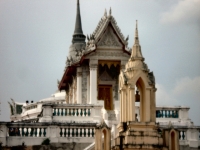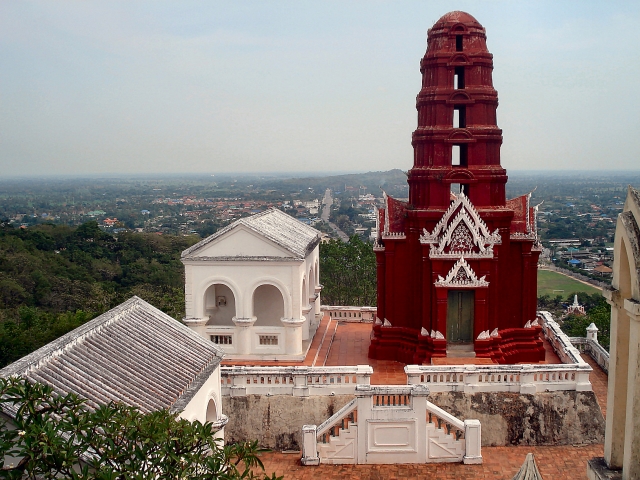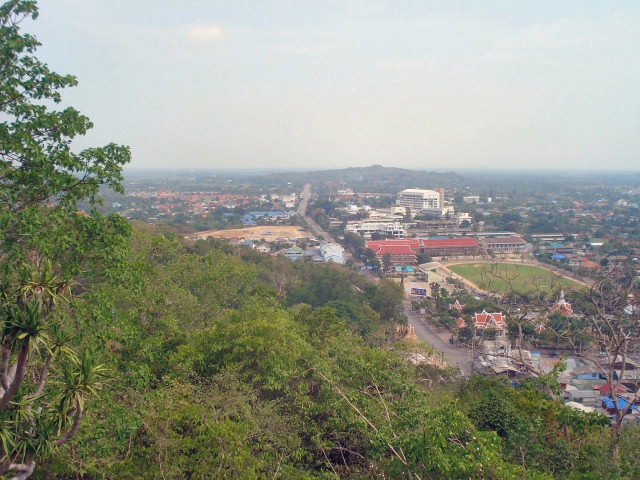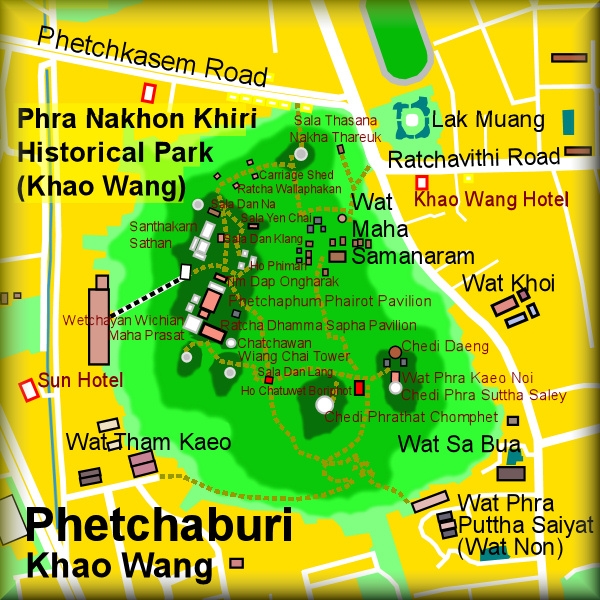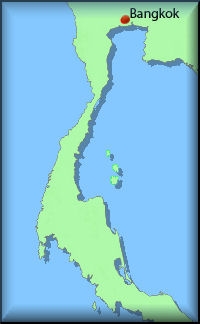 |
Nationalmuseen im Süden Thailands
Museum >>
National Museum Chumphon (National Museum, Chumphon) (Chumphon) 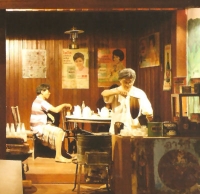 The museum stands on the Hill of Sam Kaeo Mountain, in the area of the government centre in Chumphon. The building is designed as an integrated style of local and contemporary themes, specially built for protection against strong winds, and at the same time, be appropriate for use as a museum. The museum stands on the Hill of Sam Kaeo Mountain, in the area of the government centre in Chumphon. The building is designed as an integrated style of local and contemporary themes, specially built for protection against strong winds, and at the same time, be appropriate for use as a museum.The dominant feature of the local style of architecture appears in the museum building’s structure and in the style of the exhibition as well. Inside the gallery, exhibits transmit the way the Chumphon people have lived in close relationship with their environment. It affects the style of architecture created, especially their homes. The Chumphon people live in an area where it rains all year round, and thus, the soil is softened and very fluid. Consequently, houses are not posted into the soil, but instead they will be placed upon a foundation of hard wood, stone or a cement base. The overall structure is not high; however, the floor is elevated to a height so that a man can easily walk underneath. The wall is made in louver-boards style with narrow windows. The roof is decorated with a fish-tailed style gable-end and the eaves are designed to extend out a good distance in order to prevent the rain from falling into the house. The roof pediment is usually decorated with an aura of rays from the sun. However, when Western culture began to pour in, the style of architecture began to use a new style to fit in with their lifestyle. Houses appeared more often in a two-storied structure and not as the elevated single floor home anymore. Perforated, cut-through weed designs, were considered more attractive, and gave additional ventilation and so, became fashionable. They were used to decorate the eaves, window screens, and the gable, to be more attractive. The distinguishing characteristics of the local architecture, the one-storied, elevated houses have become rare to find today. The ancient site of Sam Kaeo Mountain or “Khao Sam Kaeo” is found in a steep limestone gully in the mountain range which runs through Thung Tako, Sawee Pathiw and Pha To districts. Here, many prehistoric artifacts were found and brought for display to the museum. These include potsherds, tripods, flake and polished stone tools. The evidence shows people migrated further down the plain and settled there. Afterwards, these people interacted with other communities by land and sea. As Chumphon’s location was near the seashore, it became an early important port for trade by the 1st century A.D. This had a substantial effect on the way of life here. The place was known as “The Port of Khao Sam Kaeo.” Because it was a major trading port, many archaeological finds were excavated showing that trade flourished in both eastern and western directions, during the first century onwards; some of these artifacts are: bronze human and animal figures, iron tools, bronze drums and beads. Beads are the most important proof of the trading relationship between the community of Khao Sam Kaeo and people from overseas. Beads were made of glass and stone, and some were inscribed in the Pallava script. These beads were used as ordinary ornaments which people from India, Arab and Roman cultures brought with them while traveling here. The importance of this port continued on for four hundred years. In the meantime, many additional ports along the Andaman coastline were opened, such as the Port of Phu Khao Thong of Ranong province and Khuan Luk Pat, Khlong Thom of Krabi. Also, in the Gulf of Siam, new ports opened south of Chumphon, namely, Tha Chana and Chaiya Ports of Surat Thani and Sathing Phra of Songkhla. By the 5th century onwards, the significance of the Khao Sam Kaeo port of Chumphon began to decline. Situated to the north of Chumphon city across the railway track right by the side of bypass road H1007. Situated to the north of Chumphon city across the railway track right by the side of bypass road H1007. 1200 Years of History and Artifacts
Museum
Museum
Museum >>
Songkhla National Museum (พิพิธภัณฑสถานแห่งชาติ สงขลา) (Songkhla) Preise: 10 bis 30 Baht 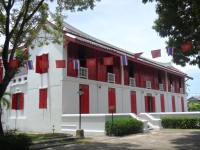 The remarkable characteristic of the museum is its architecture. It in the style of a mixture between Chinese and Western influences and was built more than a hundred years ago. The building is constructed with bricks and plaster, painted in white, while the door and window panels, including the Chinese style roofed ornaments, are in red. The roof is covered by terra cotta tiles with a perforated ridge. The capitals of columns, crossbeams and walls under the pediments are decorated with frescoes, bas reliefs in the figures of Chinese deities and floral designs which are signs of good fortune. The building has been restored from time to time and has become the become the landmark of Songkhla province for its beauty and its historic value. The building was awarded “An Art on Architecture” from the Association of Siamese Architecture in 2007. The remarkable characteristic of the museum is its architecture. It in the style of a mixture between Chinese and Western influences and was built more than a hundred years ago. The building is constructed with bricks and plaster, painted in white, while the door and window panels, including the Chinese style roofed ornaments, are in red. The roof is covered by terra cotta tiles with a perforated ridge. The capitals of columns, crossbeams and walls under the pediments are decorated with frescoes, bas reliefs in the figures of Chinese deities and floral designs which are signs of good fortune. The building has been restored from time to time and has become the become the landmark of Songkhla province for its beauty and its historic value. The building was awarded “An Art on Architecture” from the Association of Siamese Architecture in 2007.Formerly, the building was a residency of the Na Songkhla family, built in 1878 by Phraya Suntharanurak (Net Na Songkhla), a governor of Songkhla, during the reign of King Rama V. The construction was completed during his son’s, Phra Anata Sombat (Em Na Songkhla) lifetime. (Prince Phanuphan Wong Wordet.) It was given for official use in 1904, for the intendancy of Nakhon Si Thammarat precinct when Phraya Yomarat (Pan Sukhum) was the intendant. (The position of the ruler of Songkhla changed to that of a governor, and was under government authority, and served as the commander-in-chief of the precinct.) Later, during 1933-1953, (The administrative system was changed in 1917. As a consequence, Songkhla City became Songkhla Province and the ruler became the governor, under the Nakhon Si Thammarat precinct) it was used as a city hall, until the Fine Arts Department declared it as a national monument in 1973. To visit the museum, one enters the front gate and walks through a field flanked by two halls, which attach to the main building. The building is constructed in a rectangular shape around a courtyard; a big tree groups in the middle. There are two rails of stairways leading to the second floor. The space at each floor is divided into rooms and balconies which are used as the exhibition galleries. The artifacts shown, document the civilizations of the peninsula in the regions of Songkhla, Phatthalung, Satun, Pattani, Yala and Narathiwat. The exhibition starts off with prehistory of the region and continues to the historical period. Songkhla province, in particular, is where much proof in the form of artifacts, was found attesting to its importance as a leading community on the peninsula. Songkhla was mentioned in some ancient foreign documents under the names of “Singur” of “Singora.” Most of the artifacts are archaeological finds from sites around districts of Songkhla, such as in the ancient town of Sathing Phra nad other ancient communities around the Songkhla lagoon.
Museum >>
Phuket Seashell Museum (พิพิธภัณฑ์เปลือกหอย ภูเก็ต) (Phuket) |
Neu bei t-Globe?
Bitte anmelden, um diese Webseite voll zu nutzen!
Registrierte Mitglieder koennen: |
||||||||||||||||||||||||||||||||||||||||||||||
|
|

